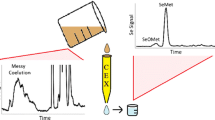Abstract
The storage characteristics of selenate, selenite, and selenomethionine in low and high ionic strength water were investigated. Each water matrix, which contained all three selenium forms, was subjected to three different selenium concentrations (10, 50, and 100 ppb), two different container materials (borosilicate glass and high density polyethylene), and two temperatures (glass: 4°C; polyethylene: −20°C) over a period of 120 days. Ligand exchange chromatography using copper chelex was used to separate organic from inorganic selenium forms.
Selenomethionine was most stable over the duration of the study, with virtually no significant influence from temperature, species concentration, container material, or water matrix. For inorganic selenium forms, significant changes in selenite were observed over 120 days, although less change was observed for solutions stored in glass. Selenate losses were observed from solutions stored under conditions of a low ionic strength matrix, polyethylene container, and freezing. Overall, the least changes among the three selenium species were observed from solutions stored in glass at 4°C.
Similar content being viewed by others
References
Besser JM, Huckins JN, Little EE, La Point TW (1989) Distribution and bioaccumulation of selenium in aquatic microcosms. Environ Pollut 62:1–12
Burau RG (1985) Environmental chemistry of selenium. Calif Agric 39:16–18
Cheam V, Agemian H (1980) Preservation and stability of inorganic selenium compounds at ppb levels in water samples. Anal Chim Acta 113:237–245
Cutter GA (1979) Species determination of selenium in natural waters. Anal Chim Acta 98:59–66
— (1982) Selenium in reducing waters. Science 217:829–831
Hamilton SJ, Buhl KJ, Faerber NL, Wiedmeyer RH, Bullard FA (1990) Toxicity of organic selenium in the diet of chinook salmon. Environ Toxicol Chem 19:347–358
Karin RW, Buono JA, Fasching JL (1975) Removal of trace elemental impurities from polyethylene by nitric acid. Anal Chem 47:2296–2299
Lee C, Bada JL (1975) Amino acids in equatorial Pacific Ocean water. Earth Planetary Sci Lett 26:61–68
Lemly AD, Smith GJ (1987) Aquatic cycling of selenium: Implications for fish and wildlife, U.S. Fish and Wildlife Service Leaflet No. 12, Washington, DC.
May TW, Kane DA (1984) Matrix-dependent instability of selenium (IV) stored in Teflon containers. Anal Chim Acta 161:387–391
Measures CI, Burton JD (1980) Gas chromatographic method for the determination of selenite and total selenium in sea water. Anal Chim Acta 120:177–186
Moody JR, Lindstrom RM (1977) Selection and cleaning of plastic containers for storage of trace element samples. Anal Chem 49:2264–2267
Oppenheimer JA, Eaton AD (1984) Speciation of selenium in groundwater. EPA-600/2–84–190, U.S. Environmental Protection Agency, Cincinnati, OH, 29 pp.
Presser TS, Barnes I (1984) Selenium concentrations in waters tributary to and in the vicinity of the Kesterson National Wildlife Refuge, Fresno and Merced counties, California. U.S. Geological Survey Water Resources Investigation Report 84-4122, 26 pp
--, --(1985) Dissolved constituents including selenium in waters in the vicinity of Kesterson National Wildlife Refuge and the West Grassland, Fresno and Merced counties, California. U.S. Geological Survey Water Resources Investigations Report 85-4220, 73 pp
Robberecht HJ, Van Grieken RF (1980) Sub-part-per-billion determination of total dissolved selenium and selenite in environmental waters by X-ray fluorescence spectrometry. Anal Chim Acta 52:449–453
—, — (1982) Selenium in environmental waters: determination, speciation and concentration levels. Talanta 29:823–844
Saiki MK (1986) A field example of selenium contamination in an aquatic food chain. In: Selenium in the environment—proceedings. California Agricultural Technology Institute Publication No. CAT1/860201, Fresno, CA, pp 67–76
Shendrikar AD, West PW (1975) The rate of loss of selenium from aqueous solution stored in various containers. Anal Chim Acta 74:189–191
Siegel A, Degens ET (1966) Concentration of dissolved amino acids from saline waters by ligand-exchange chromatography. Science 151:1098–1101
Sugimura Y, Suzuki Y (1977) A new fluorometric method of analysis of selenium in sea water. J Oceanogr Soc Jpn 33:23–29
Thompson M, Pahlavanpour B, Thorne LT (1981) The simultaneous determination of arsenic, antimony, bismuth, selenium, and tellurium in waters by an inductively coupled plasma/volatile hydride method. Water Res 15:407–411
Voth-Beach LM, Shrader DE (1985) Reduction of interferences in the determination of arsenic and selenium by hydride generation. Spectroscopy 1:60–65
Webb KL, Wood L (1967) Improved techniques for analysis of free amino acids in seawater. In: Automation in Analytical Chemistry, Technicon Symposium 1966, pp 440–444
Author information
Authors and Affiliations
Rights and permissions
About this article
Cite this article
Wiedmeyer, R.H., May, T.W. Storage characteristics of three selenium species in water. Arch. Environ. Contam. Toxicol. 25, 67–71 (1993). https://doi.org/10.1007/BF00230713
Received:
Revised:
Issue Date:
DOI: https://doi.org/10.1007/BF00230713




